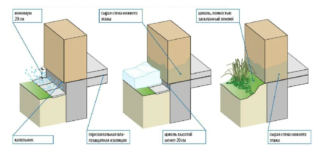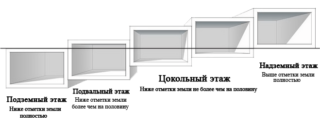The base of the house is made of moisture-resistant materials that do not get wet from snow drifts, rainwater. The height of the basement is important and varies depending on the region of construction, the material of the walls of the house and the characteristics of the soil. The above-ground base is separated by horizontal waterproofing from the walls of the building so that moisture does not penetrate into the vertical enclosing structures.
- Definition and dependence on parameters
- Functions and tasks of the base / plinth height
- Variety of base
- Speaker
- Westerner
- Flush with the walls
- Influence of the type of base on the height
- Standard and optimum base / plinth heights
- Standard
- Optimal
- Basement height when erecting buildings with a basement or basement
Definition and dependence on parameters
The height depends on the building material. For example, a timber house requires a raised base compared to a brick building. Aerated concrete and foam block almost do not absorb moisture, therefore, strict requirements for the lifting point are not observed.
The structural design of the building is also taken into account when choosing the degree of elevation. The presence of a utility block in a semi-basement space affects the level of the foundation above the ground. According to these parameters, the height of the kitchen basement is determined.
Functions and tasks of the base / plinth height
The height is determined taking into account the weather conditions of the area. The mark of the standing of soil water, the level of precipitation, the likelihood of flooding are taken into account.
Functions of the base in the building:
- prevention of wall damping;
- protection of the bottom of the exterior trim from destruction, for example, plastic;
- compensation of shrinkage forces on the ground;
- organization of ventilation of the underground space and basement.
The base of the building has a decorative meaning in the exterior. The house on a high pedestal with a staircase in the entrance group looks majestic. The finish of the raised base is chosen in harmony with the main materials of the external façade.
Variety of base
Plinth arrangement with different foundations:
- tape type - masonry or concreting;
- pile support - concreting;
- monolithic slab - brickwork or reinforced concrete.
For masonry, red fired ceramic bricks are used. The material practically does not absorb moisture and works perfectly in the structure of the base. Silicate white brick is not used, because artificial stones are highly hygroscopic.
Plinth concreting is one of the alternatives. Reinforced concrete is distinguished by its strength, components are added to the mixture that increase the resistance to moisture. Internal and external waterproofing is carried out at the same time.
Speaker
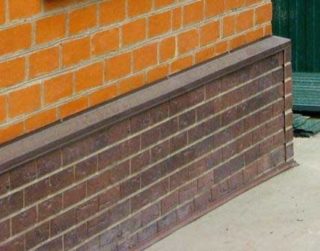
A remote base in relation to the vertical plane of the wall is often found if the vertical fence is made of modern materials with a high degree of thermal insulation and low weight. Walls made of foam blocks and foam concrete are made of minimum thickness, and the foundation and plinth need solid ones to withstand the weight of the ceiling and roof.
The junction of the wall and the protruding plinth is exposed to rain and snow penetration, despite the layer of a horizontal waterproof membrane. The connection is finished with appropriate materials and water is drained from the protruding shelf. An ebb is made with a slope from the wall, and the outer part of the pedestal is treated with impregnations.
For the protruding part, material is taken that does not contribute to the extension of the vertical to an even greater distance. Natural and artificial stone, decorative plaster are used, and frame systems are not used.
Westerner
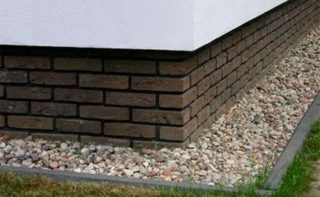
A sinking base is obtained if the walls are laid from bricks, cinder blocks, made of monolithic concrete. In this case, the foundation lies deeply, and its small width is justified by a constructive calculation. In this case, part of the wall hangs over the base, and the vertical of the pedestal is recessed.
In the second version, the overhang of the vertical fence of the house is formed when finishing the building with a frame method, for example, plastic, siding, corrugated board. The surface of the base and the horizontal joint is protected from rain, snow, and as a result it is not covered with ice.
In the recessed version, the drainage of water from the junction of the walls of the base and the house is not performed, only the vertical inner and outer surfaces are isolated.
Flush with the walls
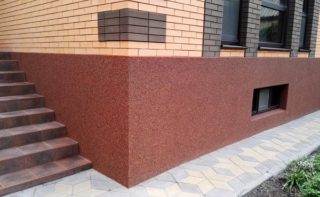
This happens if the width of the top of the base coincides with the width of the wall and the masonry does not protrude beyond the foundation. A pedestal in alignment with a wall cannot protect the structure from precipitation and condensation drainage. At the junction, 2 layers of film waterproofing are made, and a diverting ebb is placed around the perimeter.
In this version, any material for outdoor decoration is suitable, because the tiles or panels on the frame will still take out the vertical and you get a protruding base. It will remain in equal position if the base and wall finishes are of the same thickness.
The drainage system is made of galvanized steel, PVC, copper. The outer and inner areas are insulated with impregnations and roll materials.
Influence of the type of base on the height
Difficulties in determining the height of the pedestal of a one-story or multi-story building are solved if the owner turns to specialists. Technicians will make the necessary calculations and take into account all influencing factors.
Principles for finding the elevation level of the base:
- the sinking plinth is made to a height of 50 - 80 cm, because overhanging walls are in direct contact with snowdrifts and spray reflecting from the blind area;
- it is recommended to raise the protruding basement up to 60 cm to protect the house from moisture;
- the top of the base in the alignment vertically is arranged at a level of 40 - 50 cm.
If the scaffolding of the building rises to the height of the basement, a high basement is made, the degree of elevation is determined by the floor level of the first floor.
Standard and optimum base / plinth heights
The measure of elevation is defined as standard and optimal.
Sometimes raising the lower part of the house above the ground is the only way to avoid dampening the structure from dampening the walls. We are talking about the construction of a building from a bar, logs, boards, as well as frame construction. In this case, the height of the plinth is assumed to be the largest possible size.
Standard
The parameter is calculated from the surface of the earth. The choice of raising is influenced by the device for removing ground fluids from the foundation and the installation of a blind area around the perimeter of the building.
If the specified conditions are met, the standard height is:
- for ordinary country houses, the rise is chosen 30 - 40 cm above the soil level;
- urban buildings are affected by acids, alkalis, gasoline vapors, if they are located close to the carriageway, therefore, the height increases to 50 cm;
- in wooden buildings, the plinth rises 80 - 100 cm above the ground;
- in structures with a technical floor, the indicator is at the level of 1.5 - 2.0 m.
The degree of elevation of the base in relation to the level of the soil is always justified logically, the minimum height is assumed to be 15 cm. The number of storeys of a building does not affect the size of the base, this indicator affects the level of deepening of the foundation.
Optimal
The plinth is arranged to reduce the flow of moisture into the living quarters and basement space, underground garage, workshop. The optimal height is considered taking into account many factors. The height of the basement from the ground, according to the standards, can be reduced if certain work is carried out to reduce the ambient humidity.
The resistance of a low base to wetting can be increased by waterproofing. The coating, pasting and impregnating versions are used. Successful protection against moisture will protect the plinth from freezing destruction, reduce the capillary transfer of liquid to the walls of the building. Effective insulation is carried out in a combined way, when roll materials and penetrating compounds are combined.
Basement height when erecting buildings with a basement or basement
If there is a basement, holes with a section of 15 x 15 cm are provided in the walls of the basement for ventilation in increments of 150 cm, they rise more than 15 cm above the ground. The air is protected with a metal mesh to protect it from mice and covers from freezing.
Wall insulation is carried out according to the standard scheme, waterproofing inside, outside and insulation with moisture-resistant materials is provided.



